VOTES FOR WOMEN - The 19th Amendment
Introduction | Background Knowledge | Activities | Extensions | Standards
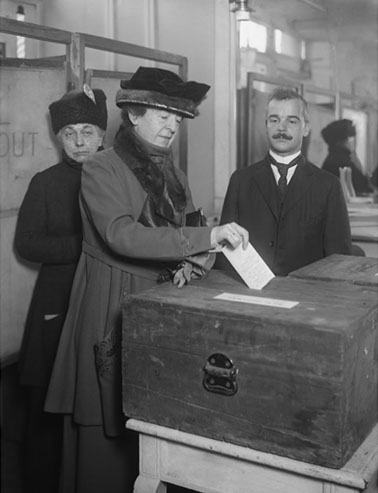
Introduction
Susan B. Anthony. Elizabeth Cady Stanton. Alice Paul. Seneca Falls Convention. Suffrage. These are all words and phrases that come to mind when the 19th Amendment is mentioned. "Votes for Women!" was the rallying cry for 72 years before the 19th Amendment was passed which guaranteed women the right to cast their ballots and make their voices heard.
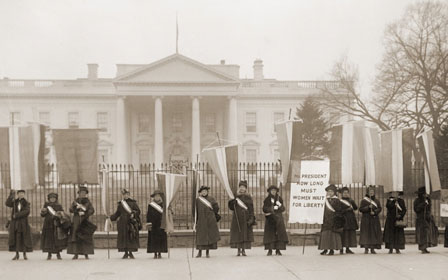
Background Knowledge
The original United States Constitution did not identify exactly who could vote in the new nation. Article I, Section 4 charges the states to prescribe the "times, places, and manners of holding elections" but allows that Congress can pass laws to "make or alter such regulations." In 1776, most states only granted white, male property owners voting rights. By 1860, with the support of President Andrew Jackson, most white males who did not own property were able to vote as well. In 1868, the 14th Amendment defined voters as exclusively male. African American men were granted the right to vote with the 15th Amendment in 1870. America's women were the last group to be given the constitutional right to vote with the 19th Amendment in 1920.
The Women's Suffrage Movement got its roots alongside the Abolitionist Movement. Elizabeth Cady Stanton and Lucretia Mott, two organizers of the first women's rights convention, met in 1840 at the World Anti-Slavery Convention. While there, they were excluded from serving as delegates because of their gender and decided to hold a women's rights convention.
Over two days in July of 1848, 300 people met together in Seneca Falls, New York, to discuss rights for women. Originally named the Women's Rights Convention, this meeting became known as the Seneca Falls Convention. Elizabeth Cady Stanton, along with four of her friends, drafted the Declaration of Sentiments. This document served as the manifesto for Seneca Falls and began with 19 cases of abuse to a woman's "confidence in her own powers, to lessen her self-respect, and to make her willing to lead a dependent and abject life." It shared 11 resolutions aimed at making women equal to men. The 300 attendees, women only on the first day, unanimously passed 10 of the 11 resolutions. The controversial resolution - number 9, the right to vote - was eventually passed by a narrow margin.
Another leader of both the abolitionist movement and the women's rights movement was Sojourner Truth. In 1851, Sojourner Truth began a lecture tour, on the heels of publishing her autobiography, that focused on women's rights. Truth, a former enslaved person, was outspoken about her advocacy for many social movements, including the abolishing of slavery, the temperance movement, and women's rights. Her national stage gave her the opportunity to meet Elizabeth Cady Stanton and Susan B. Anthony.
The excitement and momentum from Seneca Falls waned with the start of the Civil War, and the suffrage movement faded into the background, and many of the women turned their focus to the war effort. With the passage of the Reconstruction Amendments after the Civil War - which ended slavery (13th), defined citizenship (14th), and allowed all races to vote (15th) - the suffrage spark was rekindled. Many suffragists aligned with southerners in opposition to the 15th Amendment in hopes of universal suffrage. Elizabeth Cady Stanton alienated Sojourner Truth because of Stanton's refusal to support the 15th Amendment if it did not include rights for women. Many white suffragists tried to distance themselves from black suffragists who included broader civil rights issues in their fights. They actively tried to undermine the cause of black suffragists and perpetuated the stereotypes that black women were uneducated. Despite the resistance, many African American suffragists were notable for working tirelessly to help America's women get the right to vote. While not household names like their white counterparts, these women were instrumental in ensuring that women would vote. Frances Ellen Watkins Harper believed that nothing would happen until black and white women worked together. She called Stanton and Anthony out for refusing to cross the racial divide. She addressed their racist position at the 1866 Women's Rights Convention.
In 1869, Elizabeth Cady Stanton teamed up with Susan B. Anthony to form the National Woman Suffrage Association (NWSA) and began the fight for universal suffrage. Mary Ann Shadd Cary, a black lawyer, and publisher, addressed the House Judiciary Committee about the importance of having women vote four years before the NWSA lobbied Congress to draft a women's suffrage amendment in 1878. The amendment was researched and discussed at the committee level in the House of Representatives and the Senate but was defeated on the Senate floor in 1886. A second faction - the American Woman Suffrage Association - attacked the cause on a state-by-state basis. As the Progressive Movement dawned in the 1890s, the two factions merged and formed the National American Woman Suffrage Association. Elizabeth Cady Stanton served as the first president. A third group, the National Association of Colored Women (NACW), formed when black suffragists were not welcomed into the white organizations. Mary Church Terrell and Josephine St. Pierre Ruffin consolidated the black suffrage organizations across the country into the NACW.
With the deaths of Elizabeth Cady Stanton and Susan B. Anthony in the early 1900s, Carrie Chapman Catt took over, and the NAWSA began to make headway at the state level. Between 1910 and 1918, 17 states granted women the right to vote. In 1913, Alice Paul founded the Congressional Union for Woman Suffrage and was a bold and outspoken advocate for the suffrage movement.
On the night before President Woodrow Wilson was inaugurated in 1913, women staged a suffrage parade in Washington, D.C. Wilson entered the White House as an opponent to women's suffrage but changed his stance with influence from Carrie Chapman Catt. In 1918, Wilson addressed Congress in support of the suffrage movement. After Wilson's address, the amendment failed by 2 votes in Congress and would not be discussed again until a year later.
In May 1919, Republican Representative James R. Mann introduced the Susan B. Anthony Amendment to the House of Representatives. It passed with 42 votes, more than the required two-thirds majority. About a month later, in June, the vote passed in the Senate with 2 votes over the two-thirds majority and went to the states for ratification.
Several states ratified the amendment immediately, but many Southern states opposed the amendment and rejected it. Finally, on August 18, 1920, the state legislators of Tennessee met to vote on the amendment. Representative Harry Burn, influenced by his mother, cast the deciding vote in favor of the 19th Amendment.
On November 2, 1920, over 8 million American women cast their first legal votes for President of the United States and other races across the country.
Over the next 64 years, the twelve states that rejected the 19th Amendment finally voted to ratify it, with Mississippi the last state to do so in 1984.
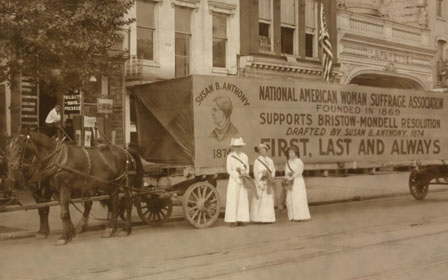
ACTIVITIES
Selective List of Books
-
Finish the Fight! The Brave and Revolutionary Women Who Fought for the Right to Vote! By Veronica Chambers and the Staff of the New York Times (ISBN 9780358408307)
- The New York Times's Suffrage at 100: A Visual History pairs primary sources with commentary on the suffrage movement.
- The New York Times presents 19 Ways to Teach the 19th Amendment. The resource provides activities and lesson plans to help students examine multiple facets of the suffrage movement.
- Finish the Fight is a special, vibrant performance of oral storytelling of some of the life stories of the activists. Please note you can only view one article without a paid NY Times subscription.
-
The Voice that Won the Vote by Elisa Boxer (ISBN 9781534110469)
- Read about the letter that Febb Burn wrote to her son, Harry, on the eve of his historic vote to ratify the 19th Amendment.
- Take a virtual visit to the Tennessee State Museum to see a county-by-county look at the ratification of the 19th Amendment. There are also guiding questions provided by the museum.
-
Fight of the Century by Barb Rosenstock (ISBN 9781629799087)
- Alice Paul was an outspoken supporter of the suffrage movement. This book, structured like a boxing match, makes the meetings between Alice Paul and President Woodrow Wilson accessible to students.
- The National Park Services outlines Alice Paul's fight for suffrage and her meetings with President Wilson.
- Learn more about Alice Paul and Woodrow Wilson here.
- Find activities in this educator's guide and find more resources and texts to pair with the book here.
-
Lifting as We Climb by Evette Dionne (ISBN 9780451481542)
- Many suffragists fighting for the right to vote were African American women. They were fighting battles in a number of fights and many of their contributions have been overshadowed by white suffragists who did not see them as equals.
- The Smithsonian has curated a list of five African-American suffragists people should know.
- Listen to Sojourner Truth's "Ain't I a Woman?" speech and use the transcription of the speech to discuss how this speech can be seen as a rallying cry for suffragists. The original version of the speech is printed alongside a disputed transcription. Older students can compare the two versions and discuss the differences.
-
Suffragette: The Battle for Equality by David Roberts (ISBN 9781536208412)
- Tracking the suffrage movement from England across the pond to America, this book touches on the trials and tribulations of women fighting for the right to vote.
- Rutgers University also has a list of resources that includes discussion questions and activities organized by grade level.
-
I Could Do That by Linda Arms White (ISBN 9780374335274)
- Wyoming was the first state to allow women to vote. This is the story of Esther Morris and her push to get the right to vote.
- A statue of Esther Morris stands in Statuary Hall in the US Capitol, given by Wyoming in 1960.
-
Around America to Win the Vote: Two Suffragists, a Kitten, and 10,000 Miles by Mara Rockliff (ISBN 9780763678937)
- Nell Richardson and Alice Burke left New York City in April 1916 to spread the word across the country about the women's suffrage movement.
- Follow their trip with a TeachersFirst Reading Trek. Explore the suggested activities for younger students in the attached document for teachers and librarians.
- Pair the picture book with primary sources and a lesson plan from Citizen U.
- Extend the lesson with this teacher's guide.
Primary Sources
- The Library of Congress is an excellent resource for primary sources. This collection of sources can supplement this week-long lesson plan to help students explore primary sources and create their own.
- Digital History of the University of Houston provides many primary source analysis tools. The site also has guiding questions for primary source analysis.
Webquest Research Project
- The Historical Society of Pennsylvania presents a very thorough WebQuest activity. Geared for late middle school and high school, students act as newspaper reporters and research the suffrage movement to create their own newspaper. The activity is thorough, and all materials are provided and can be modified for your students. If the sources are provided, this activity could be modified for upper elementary as well.
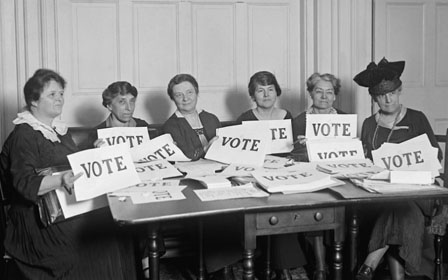
EXTENSION
Interview with a Suffragist
- The Children's Theater of Cincinnati created and recorded a stage production for young people called "Suffragettes: With Liberty and Voting for All." After watching the play with your students, challenge them to write their own production. Students can present their work to their classmates and, if technology allows, record it to share with others.
Create Your Own Documentary
-
View Susan B. Anthony and Elizabeth Cady Stanton: The Fight for Women's
Rights a student-created video, which offers many interesting details about their lives in a unique storytelling manner. Working in pairs or small groups, students could create their own videos telling the stories of other suffragists using the provided video as inspiration.
- Non-technology Approach: Students write their own production and stage it for their classmates, much like Reader's Theater.
- Technology Approach: Students can create their own videos using Adobe Creative Cloud Express for Education (TeachersFirst review), Animoto (TeachersFirst review), or Canva (TeachersFirst review).
Mock Debate
- To extend for middle and high school students, use the PBS Women's History Activity Pack to hold a mock convention and present arguments for and against women's right to vote.
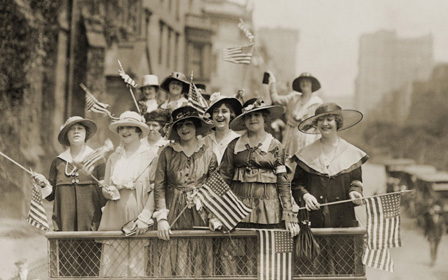
CORRELATION TO STANDARDS
-
AASL National School Library Standards
- Inquire Shared Foundation, Think Domain - Learners display curiosity and initiative by: 1. Formulating questions about a personal interest or a curricular topic. 2. Recalling prior and background knowledge as context for new meaning
- Inquire Shared Foundation, Grow Domain - Learners participate in an ongoing inquiry-based process by: 1. Continually seeking knowledge
- Include Shared Foundation, Create Domain - Learners adjust their awareness of the global learning community by: 2. Evaluating a variety of perspectives during learning activities
- Include Shared Foundation, Grow Domain - Learners demonstrate empathy and equity in knowledge building within the global learning community by: 2. Demonstrating interest in other perspectives during learning activities
- Curate Shared Foundation, Create Domain - Learners gather information appropriate to the task by: 2. Collecting information representing diverse perspectives
- Explore Shared Foundation, Think Domain - Learners develop and satisfy personal curiosity by: 1. Reading widely and deeply in multiple formats and write and create for a variety of purposes. 2. Reflecting and questioning assumptions and possible misconceptions.
- Explore Shared Foundation, Share Domain - Learners engage with the learning community by: 1. Expressing curiosity about a topic of personal interest or curricular relevance
- ISTE Standards for Students
- Knowledge Constructor - 3d. Students build knowledge by actively exploring real-world issues and problems, developing ideas and theories and pursuing answers and solutions.
